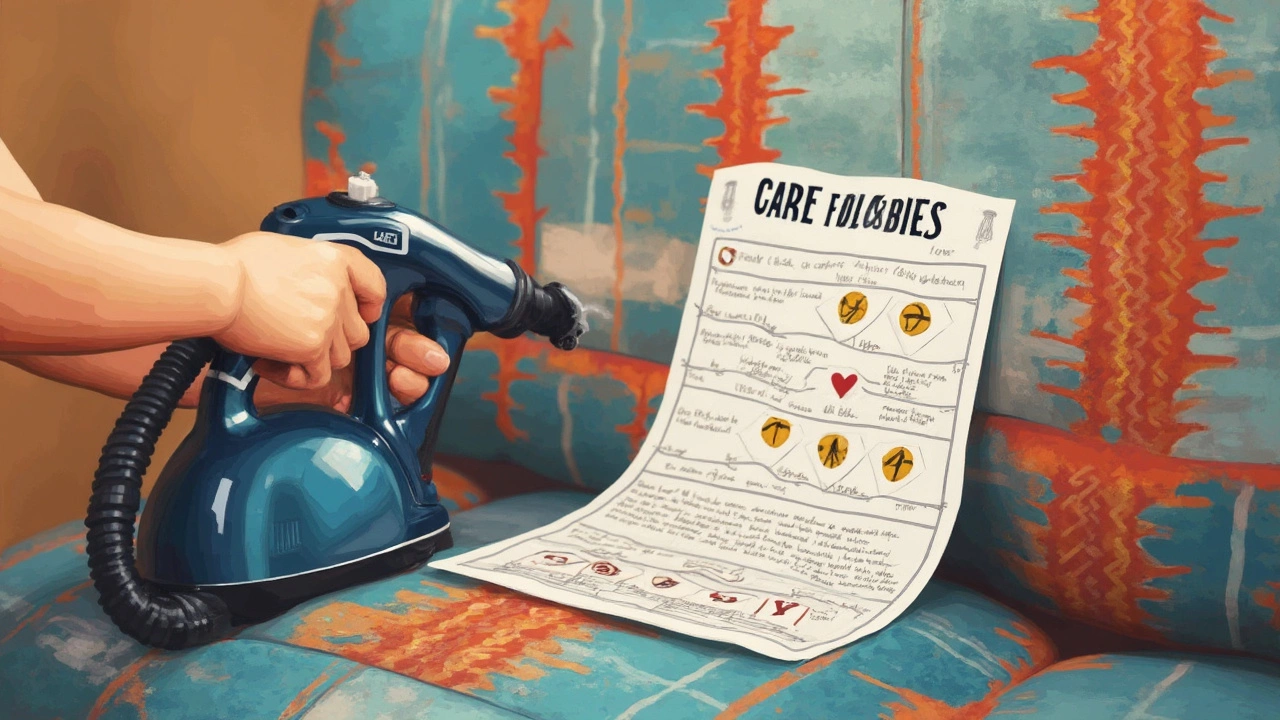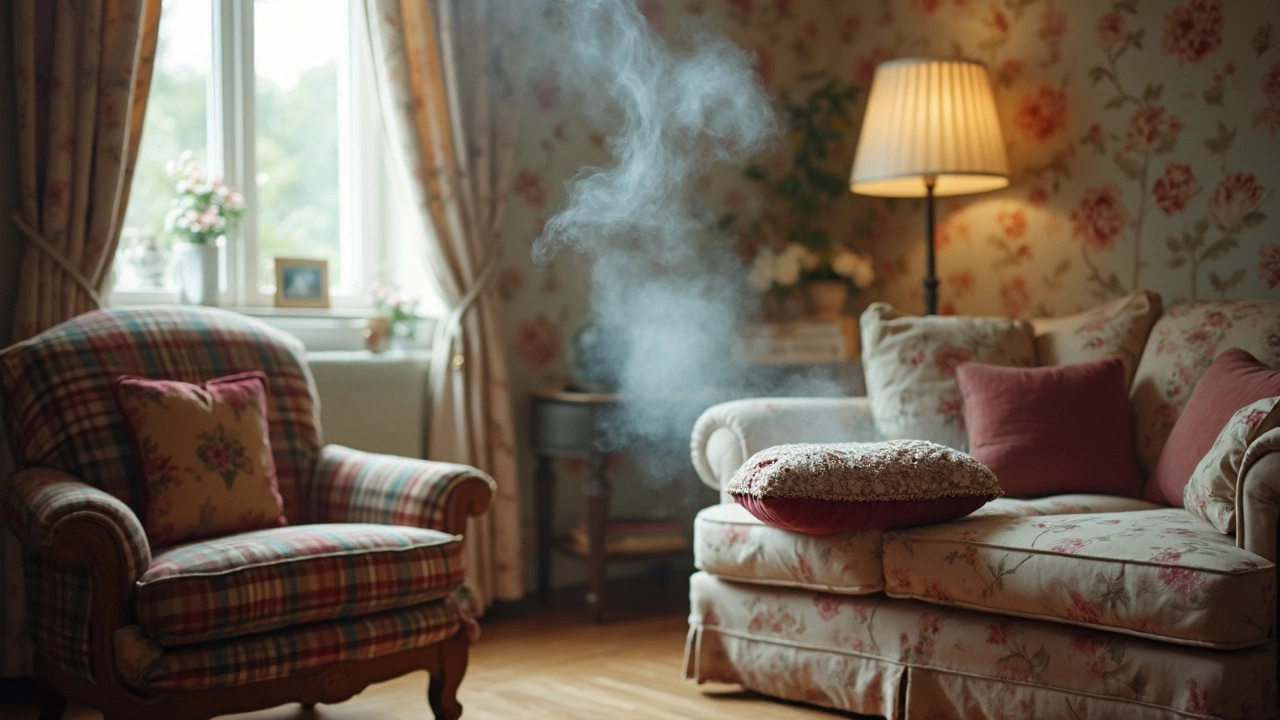Ever get the urge to blast your stained sofa with a steam cleaner? Hold up! Steam seems like a magic fix, but it can ruin the wrong type of upholstery before you even notice. Lots of people have learned this the hard way, like when microfiber cushions turn blotchy or velvet gets crushed for good.
The thing is, not all fabrics are steam-friendly. Some can shrink, fade, or even lose their texture completely. There’s also the leftover moisture issue, which creates a perfect breeding ground for mold and funky smells if your furniture can’t dry fast enough.
Before you even think about steaming your couch or armchair, take a close look at those tiny care tags most folks ignore. If you see an “X” or “S” on the label, skip the steam. Trust me, the headaches you’ll save are worth the minute it takes to check.
- Why Steam Isn’t Always Safe
- Types of Fabrics That Hate Steam
- Situations Where Steam Does More Harm Than Good
- What to Do Instead of Steaming
Why Steam Isn’t Always Safe
Using a steam cleaning machine on your couch or armchair might seem like a no-brainer, but it can backfire fast in ways you don’t expect. Heat and moisture together can seriously damage some types of upholstery. The main thing to know is that certain materials react badly—they might shrink, lose their shape, or get permanent water stains. Ever seen someone’s linen sofa turn into a wrinkled mess? That’s the steam talking.
Another issue is the heat. A lot of synthetic fabrics, like polyester blends, look tough but can actually melt or get warped under high temperatures. Basically, if the fabric gets too hot, its texture changes forever. That’s not something you can just fix with a hair dryer.
There’s also the problem of trapped moisture. If steam sinks in deep and the inside cushions can’t dry quickly, you’re looking at possible mold or mildew a few days later. Nobody wants their couch, or even worse, their mattress, to smell like a damp basement.
And check this out—most upholstery cleaning tags actually mark if steam isn’t safe. Here’s what those letters mean:
- W: Water-based cleaners are okay.
- S: Only use solvent-based cleaners—steam is out.
- WS: You’ve got options, but still proceed with caution.
- X: Keep away from both water and solvents. Vacuum only—definitely not steam cleaning.
If you ignore those care codes, you could void the warranty or ruin the furniture for good. Quick tip: if you’re not sure what your upholstery is made from, test a tiny hidden spot before unleashing steam on the whole thing.
Types of Fabrics That Hate Steam
If you want to keep your furniture looking good, you have to know which materials just can’t handle steam cleaning. Some fabrics are super sensitive to heat and moisture, and bringing in a steam cleaner could leave you with shriveled, warped, or ruined upholstery. Always pause before you haul out the heavy equipment—some fabrics just aren’t built for it.
- Velvet: Steam and velvet are a recipe for disaster. The fibers can flatten or get odd marks that won’t come out. Over time, the heat may even mess up the pile so it never looks plush again.
- Silk: This one is a no-go with upholstery cleaning. Silk gets water spots, the color fades, and the fabric can lose strength. You’re more likely to ruin it than refresh it.
- Leather: Steam adds moisture that can dry out leather, making it crack and lose flexibility. Plus, you risk leaving ugly marks that don’t buff out easily.
- Suede: Suede acts like a sponge—moisture and heat can make it stiff or even warp, taking away that soft finish for good.
- Natural Fibers Like Linen and Wool: Both tend to shrink with heat. Linen especially can get puckered or lose shape. Wool may felt up and get rough, so it’s best handled with dry methods.
- Microfiber (sometimes): Microfiber is tricky—it reads as “easy care,” but some blends react to steam cleaning with water spots or shrinkage. Always check your tag for a warning before risking it.
Want to see the most common steam-unfriendly fabrics side by side? Here’s a simple table:
| Fabric Type | Common Problems With Steam |
|---|---|
| Velvet | Flattening, permanent marks |
| Silk | Staining, color fading, weakening |
| Leather | Cracking, discoloration |
| Suede | Stiffening, loss of texture |
| Linen | Shrinking, puckering |
| Wool | Felting, roughness, shrinking |
Here’s a quick tip: Look for cleaning codes on your furniture’s tag. If you spot an “S” (solvent only) or an “X” (vacuum only), hands off the steam. That’s your best chance of keeping your furniture in top shape.

Situations Where Steam Does More Harm Than Good
Shooting steam at upholstery isn’t always a win. There are some clear moments when using a steam cleaning machine on your furniture is going to end badly. Let’s run through a few of the top situations where heat and moisture spell trouble for your stuff.
- Older furniture with fragile fabric: Antique or vintage chairs and sofas are usually made with delicate materials or special glue holding the frame together. Blasting them with hot steam can weaken old fibers and mess with the overall structure. I’ve seen old armchairs literally start shedding fabric after one bad steam session.
- Pieces with natural or unfinished wood: Any time steam gets into raw or lightly finished wood, it can cause swelling, warping, and even cracking. Avoid steam on armrests, legs, or frames that aren’t sealed tight.
- Upholstery with stains that react to heat: Some stains, like blood or protein-based spills, get cooked in when exposed to steam. That makes them way harder (sometimes impossible) to remove later.
- Furniture with metal components: Think of recliners or chairs with hidden springs. Moisture from steam leads to rust over time. You won’t notice right away, but a creaky, rusty recliner a year later is no fun.
- Rooms with poor ventilation: If your space doesn’t dry quickly after steam cleaning, you’re looking at a real risk for mold and mildew growth. Nobody enjoys a musty couch or a room that smells like a basement.
- Stuffed furniture with foam or down pillows: Steam makes these interior materials hold moisture much longer. That leads to a lumpy, saggy, or even smelly result.
Experts have pointed out that improper upholstery cleaning is a major reason for warranty claims. One manufacturer reported around 40% of rejected warranty requests were linked to water or heat damage, and almost all had been "steam cleaned" at home. That’s a lot of ruined couches.
The bottom line: if you don’t know exactly how your furniture is built or what’s hiding under the fabric, playing it safe and skipping the steam cleaning is the smart move.
What to Do Instead of Steaming
If steam cleaning isn't safe for your upholstery, no worries. There are other ways to keep your furniture looking top notch. The method depends on the fabric, so check the care label before jumping in. For anything marked “S” or “X,” avoid all moisture-based cleaning, including steam.
Here are some solid alternatives to steam cleaning that work for a ton of fabrics:
- Dry cleaning solvent: For “S” labeled fabrics, pick up a water-free solvent from a supermarket or hardware store. Spot-test first. Use a clean white cloth, dab the solvent on the stain, and blot—it lifts stuff out without soaking the material.
- Vacuuming regularly: A vacuum with a brush attachment gets the job done for crumbs, dirt, pet hair, and even a fair share of dust mites. It’s super safe for just about any upholstery and doesn’t mess up the fabric.
- Baking soda trick: Sprinkling a thin layer of baking soda can help neutralize smells. Let it sit for at least 30 minutes (overnight for strong odors), then vacuum it up. No moisture, no fuss.
- Foam upholstery cleaner: These are designed for delicate fabrics. Just follow the instructions, go light, don’t soak anything, and blot dry when finished.
- Professional cleaning for tough cases: If your furniture is especially expensive, vintage, or stained by who-knows-what, pros have special upholstery cleaning tools that don’t need steam or even moisture.
Never use colored cloths or to scrub too hard—rubbing can fade or pill the fabric. Test any cleaner in a hidden spot first to dodge nasty surprises. Remember, cheap fixes can cost a lot in regret if your couch ends up blotchy or shriveled.
| Fabric Label | Recommended Cleaning Method | Should You Steam? |
|---|---|---|
| W | Water-based cleaners, some steam | Sometimes safe |
| S | Solvent-based cleaner (no water) | No |
| WS | Water or solvent-based | Occasionally |
| X | Vacuum only | No way |
Bottom line? There’s always a better way if steam cleaning is off the table. Check your label, be gentle, and don’t panic over the occasional spill—most messes have a safe fix with the right approach.
